Understanding Crohn's Disease: Symptoms, Causes, and What to Expect in 2025
Crohn's disease is a chronic condition that affects millions. This guide explores the symptoms of Crohn’s disease, including how it manifests in females, the stages of active Crohn's, and what to expect when living with this condition. View real-life Crohn's disease pictures and learn about treatment options.

How Crohn’s Disease Affects the Body
Crohn’s disease creates inflammation that extends through the entire thickness of the bowel wall, unlike other inflammatory bowel diseases that may only affect surface layers. This inflammation can occur in patches, leaving healthy tissue between affected areas. The most commonly affected regions include the small intestine and the beginning of the large intestine, though any part of the digestive system can be involved.
The condition affects more than just the digestive system. Patients often experience systemic symptoms including fatigue, fever, and weight loss. The chronic inflammation can lead to complications such as strictures, where the intestinal wall thickens and narrows, or fistulas, which are abnormal connections between different parts of the intestine or between the intestine and other organs. Joint pain, skin problems, and eye inflammation are also common manifestations of this systemic disease.
Symptoms of Crohn’s Disease in Females
Women with Crohn’s disease may experience unique challenges related to their reproductive health and hormonal changes. Menstrual irregularities are common, particularly during disease flares, and some women may experience delayed puberty if the condition develops during adolescence. Iron deficiency anemia occurs more frequently in women due to menstrual blood loss combined with intestinal bleeding and poor nutrient absorption.
Pregnancy considerations are particularly important for women with Crohn’s disease. While many women with well-controlled disease can have healthy pregnancies, active inflammation can increase risks for both mother and baby. Fertility may be affected, especially if pelvic surgery has been necessary. Women planning pregnancy need specialized care to optimize disease management and medication safety throughout conception and pregnancy.
What to Expect with Active Crohn’s Disease
Active Crohn’s disease presents with periods of flare-ups alternating with times of remission. During active phases, patients typically experience persistent diarrhea, often with blood or mucus, accompanied by abdominal cramping and pain. The pain is frequently located in the lower right abdomen but can occur anywhere depending on which part of the intestine is affected.
Unintended weight loss is common during active disease due to decreased appetite, malabsorption of nutrients, and increased caloric needs from inflammation. Many patients report severe fatigue that goes beyond normal tiredness, significantly impacting work, social activities, and quality of life. Fever and night sweats may occur during particularly severe flares, and some individuals develop mouth ulcers or perianal complications.
What Crohn’s Disease Pictures Can Show
Medical imaging plays a crucial role in diagnosing and monitoring Crohn’s disease progression. CT scans and MRI images can reveal characteristic signs including bowel wall thickening, narrowed intestinal segments, and inflammatory changes in surrounding tissues. These images help physicians identify complications such as abscesses, fistulas, or strictures that may require immediate intervention.
Endoscopic procedures provide direct visualization of the intestinal lining, showing distinctive features like cobblestone appearance, deep ulcerations, and skip lesions where inflamed areas are separated by normal tissue. Capsule endoscopy, where patients swallow a pill-sized camera, can capture images of the small intestine that are difficult to reach with traditional endoscopes. These visual assessments are essential for determining disease severity, monitoring treatment response, and planning surgical interventions when necessary.
Treatment Options for Crohn’s Disease in 2025
Modern Crohn’s disease treatment follows a personalized approach based on disease location, severity, and individual patient factors. Biologic medications have revolutionized treatment, with options including anti-TNF agents, integrin receptor antagonists, and interleukin inhibitors. These targeted therapies work by blocking specific inflammatory pathways, offering better outcomes with fewer side effects than traditional immunosuppressants.
| Treatment Category | Examples | Typical Annual Cost Range |
|---|---|---|
| Biologic Medications | Humira, Remicade, Stelara | $40,000 - $80,000 |
| Immunomodulators | Azathioprine, Methotrexate | $500 - $3,000 |
| Corticosteroids | Prednisone, Budesonide | $200 - $1,500 |
| Aminosalicylates | Sulfasalazine, Mesalamine | $1,000 - $4,000 |
Prices, rates, or cost estimates mentioned in this article are based on the latest available information but may change over time. Independent research is advised before making financial decisions.
Emerging treatments in 2025 include precision medicine approaches using genetic testing to predict treatment responses, advanced endoscopic therapies for stricture management, and novel oral medications that offer convenience advantages over injection-based biologics. Dietary therapies, including exclusive enteral nutrition and specific elimination diets, are gaining recognition as both induction and maintenance treatments, particularly in pediatric patients.
Surgery remains an important treatment option when medications cannot control symptoms or complications develop. Modern surgical techniques emphasize bowel preservation and minimally invasive approaches. Strictureplasty can widen narrowed areas without removing intestinal segments, while laparoscopic procedures reduce recovery time and improve cosmetic outcomes.
The landscape of Crohn’s disease management continues evolving with advances in understanding disease mechanisms and treatment personalization. Early diagnosis, appropriate treatment selection, and ongoing monitoring remain key to achieving remission and preventing complications. Patients benefit from multidisciplinary care teams including gastroenterologists, nutritionists, and mental health professionals to address the complex challenges this chronic condition presents.
This article is for informational purposes only and should not be considered medical advice. Please consult a qualified healthcare professional for personalized guidance and treatment.




